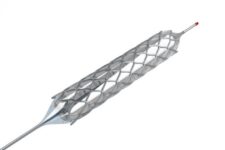Original title: Reasonable incomplete revascularisation after percutaneouscoronary intervention: the SYNTAX Revascularisation Index. Reference: Philippe Généreux et al. EuroIntervention 2014;10-online publish-ahead-of-print. While the absolute amount of residual disease after coronary angioplasty is associated with poor prognosis, the proportion of treated coronary disease modifying the prognosis is still to be determined. This study attempted to quantify the proportion of coronary…
Lower Rates of In-Stent Thrombosis with the New Generation DES
Original title: New-generation drug-eluting stents reduce stent thrombosis and myocardial infarction: a propensity-score-adjusted analysis from the multicenter REAL registry. Reference: Vignali L et al. Cath Cardiovasc Interv. 2014; Epub ahead of print. Compared to the first generation of drug eluting stents (DES), the new generation has a lower long term risk of in-stent thrombosis and acute myocardial infarction…
PCI Superior to Optimal Medical Treatment in Patients with Ischemic Cardiomyopathy
Original title: Fractional Flow Reserve–Guided PCI for Stable Coronary Artery Disease. The FAME 2 Trial Investigators. Reference: Bernard De Bruyne et al. N Engl J Med 2014;371:1208-17. The FAME 2 and the COURAGE studies tested similar hypothesis, only in the first study PCI was guided by fractional flow reserve (FFR) in addition to an angiography. The study hypothesis…
More evidence for unprotected left main PCI
Original title: Outcomes After Emergency Percutaneous Coronary Intervention in Patients UIT unprotected Left Main Stem Occlusion. The BCIS National Audit of Percutaneous Coronary Intervention 6-Years Experience. Reference: Niket Patel, et al. J Am Coll Cardiol Interv 2014;7:969-80 AMI involving unprotected left main is not frequent in catheterization labs since most of these cases present in shock. There is…
The higher the bleeding risk, the greater the benefit of radial access in terms of mortality
Original title: Baseline bleeding risk and arterial access site practice in relation to procedural outcomes after percutaneous coronary intervention. Presenter: Mamas A. Mamas et al. J Am Coll Cardiol. 2014;64:1554-1564. The transradial approach has been associated with reduced access site related bleeding complications as well as a reduced mortality in the context of PCI. It seems…
Outcomes are still associated to operator experience and institutional volume
This study is a retrospective analysis of 2,243,209 PCI stenting procedures in the USA between 2005 and 2009. During this period, a reduction in the number of PCI procedures was observed (also observed globally) from 53 in previous years to 33 procedures per operator per year, and from 1,024 to 693 per hospital per year.…
Most of stable patients have the wrong idea about the purpose of PCI
Original title: Variation in patients’ perceptions of elective percutaneous coronary intervention in stable coronary artery disease: cross sectional study. Referencia: Kureshi F et al. BMJ. 2014;Epub ahead of print. This study included 991 consecutive patients with stable coronary disease undergoing elective PCI in 10 university and community centers between 2009 and 2011. After procedure, patients were asked a…
Less Definite Thrombosis with Everolimus Eluting Stents
Original title: Three-Year Outcomes After Revascularization With Everolimus-and Sirulimus -Eluting Stents From the SORT OUT IV Trial. Reference: Lisette Okkels Jensen et al. J Am CollCardiolIntv, 2014;7: 840-8. Drug eluting stents (DES) have been shown to safely and effectively reduce restenosis compared to bare-metal stents. While the risk of thrombosis remains a matter of concern when it comes…
Direct Implantation of Drug Eluting Stents does not reduce restenosis
Original: Direct drug-eluting Stenting to reduce stent reestenosis (STRESSED). Reference: Wouter S. Remkes et al. J Am Coll Cardiol Intv, 2014;7: 751-8. Direct stenting, without predilation, has been considered a safe and effective technique that reduces procedural time, radiation exposure, contrast material and costs; however, the pertinent studies tested conventional stents only. This study aimed at assessing whether…
Minimal Lumen Area Criteria for Functionally Significant Intermediate Left Main Coronary Artery Stenosis
Original title: Intravascular Ultrasound-Derived Minimal Lumen Area Criteria for Functionally Significant Left Main Coronary Artery Stenosis. Reference: Seung-Jung Park et al. J Am Coll Cardiol Intv. 2014;7(8):868-874. Deciding on a course of action when facing intermediate main left stenosis is usually challenging. We tend to overestimate the lesion or to use additional methods, other than angiography, to tip…
Percutaneous Coronary Intervention to Unprotected Left Main Stem In Different Coronary Syndromes
Original title: Comparative Outcomes After Unprotected Left Main Stem Percutaneous Coronary Intervention: A National Linked Cohort Study of 5,065 Acute and Elective Cases From the BCIS Registry (British Cardiovascular Intervention Society). Reference: Sami S. Almudarra, et al. JACC Cardiovasc Interv 2014;7:717-30 Although myocardial revascularization surgery has long been the gold standard treatment for left main lesions, PCI has…










